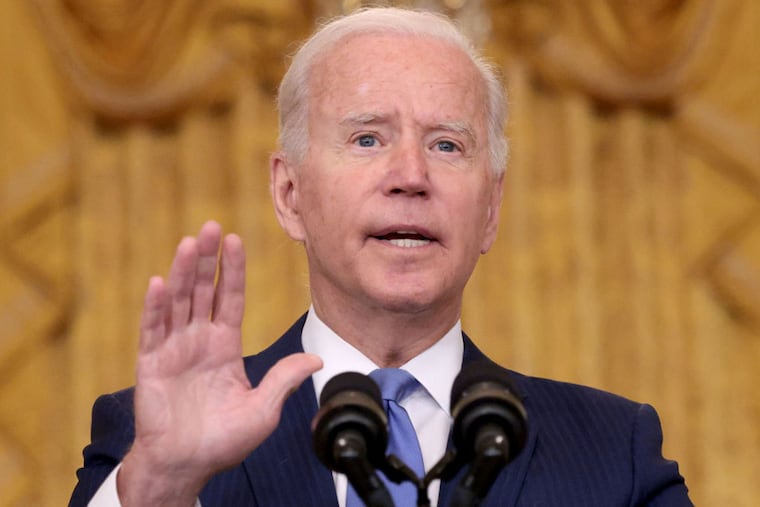President Biden confronts extreme heat, a silent climate killer
Several analyses have shown that extreme heat disproportionately harms Americans of color, as well as the elderly and the poor.

WASHINGTON - President Joe Biden launched a government-wide strategy Monday to combat extreme heat, including the development of new federal labor standards aimed at protecting workers from the impact of rising temperatures linked to climate change.
Extreme heat has cost the lives of hundreds of Americans this summer and affected the health and livelihoods of many thousands more. It now ranks as the leading weather-related cause of death in the country, according to the National Weather Service.
The push could lead to new federal Occupational Safety and Health Administration standards for employers, as well as more funding for cooling centers and other efforts to reduce heat-related illness and death. Nearly two-thirds of Americans live in places that experienced a multiday heat wave between June and August, according to a recent Washington Post analysis.
The initiative comes after wildfires and floods threatened Americans across the country this summer, from the Caldor Fire in California to the deadly remnants of Hurricane Ida in Louisiana, New York and New Jersey. After a heat dome roasted the Pacific Northwest in June, at least 115 people died in Oregon. Many of them lacked access to air conditioning.
In a statement, Biden said that six federal agencies would coordinate to protect vulnerable populations - including outdoor workers, children and the elderly - from heat-related illnesses and other public health risks linked to rising global temperatures. Unlike more dramatic disasters, he noted, extreme heat often poses a silent but deadly menace.
“While we have all seen the graphic and heart-wrenching images of superstorms, wildfires, and floods in recent weeks, another climate disaster is lurking just below the radar: extreme heat,” he said.
The Labor Department will undertake an initiative “to protect outdoor workers, including agricultural, construction, and delivery workers, as well as indoor workers, including those in warehouses, factories, and kitchens” from outdoor heat exposure, according to a White House fact sheet.
Labor’s OSHA will develop a nationwide workplace heat standard, the White House said, which does not currently exist.
Some states have begun to establish such standards, and workers’ rights advocates welcomed such a move. However, new regulations could spark pushback from employers, since they are likely to add costs to their operations.
Marc Freedman, vice president of workplace safety at the U.S. Chamber of Commerce, said in an email that his group urges OSHA “to recognize the unique difficulties with this issue” as it starts to craft the rule.
“Heat is a very challenging hazard to regulate since there is no common threshold of risk and employees react differently to exposure,” Freedman said.
Several analyses have shown that extreme heat disproportionately harms Americans of color, as well as the elderly and the poor. And as temperatures rise in the years to come, economists project that hotter days will cost the U.S. economy billions of dollars in terms of lost productivity.
A study published last week in the journal Environmental Research Communications found that each additional day above 32 degrees Celsius (90 degrees Fahrenheit) in the United States lowers annual payroll by 0.04% - equivalent to 2.1% of average weekly earnings.
“It’s good to set these kinds of standards for purely economic reasons,” said Gernot Wagner, a climate economist at New York University and co-author of the study.
Debbie Berkowitz, who served as chief of staff and senior policy adviser at OSHA during the Obama administration, praised the announcement as a way to protect the “majority Black, Brown and immigrant workers who are the day laborers doing all the construction projects and who are the farmworkers out there feeding us.”
Still, OSHA could take several years to finalize the new heat standard, experts said. The agency’s standard-setting division declined nearly 27% between 2010 and 2020, according to congressional budget documents.
Jordan Barab, who served as deputy assistant secretary of OSHA under President Barack Obama, recalled that it took the agency roughly two decades to issue a 2016 health standard reducing the amount of crystalline silica dust people could be exposed to in the workplace. The dust can cause silicosis, an irreversible and sometimes fatal respiratory disease.
“The intention is great, but I’m questioning whether OSHA has the resources,” Barab said.
California, Washington and Oregon are among a handful of states with heat standards for those working outdoors. Heat-related injuries have declined in California, which introduced the first such standard in 2005, according to research from the Washington Center for Equitable Growth.
In addition to the new workplace rule, the Health and Human Services Department will steer existing funding toward low-income households to help buy air-conditioning units, while the Environmental Protection Agency will work to establish cooling centers in schools.
“Rising temperatures pose an imminent threat to millions of American workers exposed to the elements, to kids in schools without air conditioning, to seniors in nursing homes without cooling resources, and particularly to disadvantaged communities,” Biden said. “My administration will not leave Americans to face this threat alone.”
Biden also called on Congress to pass the $3.5 trillion tax-and-spending proposal that would unlock more funding to address climate change and make the nation’s infrastructure more resilient to weather disasters.